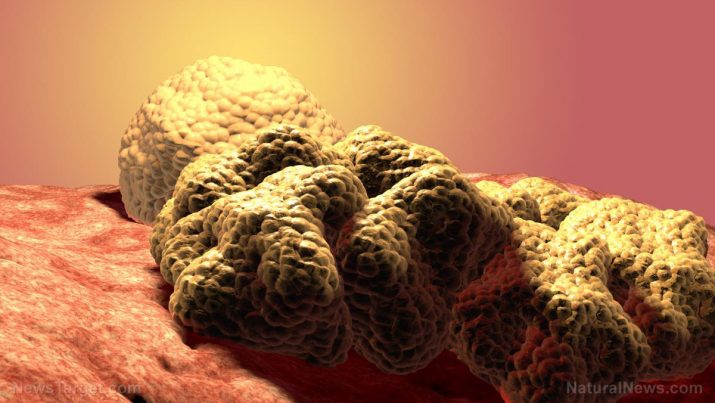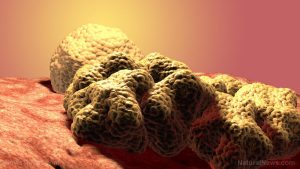
Hemangiopericytoma – causes, side effects and treatments at NaturalPedia.com
Thursday, May 03, 2018 by Zoey Sky
http://www.naturalpedia.com/hemangiopericytoma-causes-side-effects-and-treatments-at-naturalpedia-com.html

Hemangiopericytoma refers to a group of tumors that form from pericytes.
Pericytes are cells that are wrapped around endothelial cells found along capillaries (blood vessels) and venules all over the body.
Hemangiopericytoma can occur anywhere in the body. These tumors can often be found near the brain, head, neck, pelvic area and lower extremities.
These tumors are usually slow-growing and they can be either benign (non-cancerous) or malignant (cancerous). Malignant tumors may extend to another bodily region, such as the lungs and bones. Hemangiopericytomas can also be found in the nasal cavity and paranasal sinuses. While rare, prognosis for these tumors is better since they aren’t as aggressive and don’t metastasize.

Known side effects of hemangiopericytoma
The side effects of hemangiopericytoma usually depend on the location of the tumor, type of tumor (i.e. non-cancerous or cancerous), and stage.
Side effects of these tumors may include:
- Deep-seated lobulated inflammation
- Hypoglycemia may occur (depending on the site)
- Inflammation may be restricted to localized locomotion
- Intestinal or urinary symptoms — Can occur if hemangiopericytoma tumor develops in the abdomen.
- Lobulated (has an appearance resembling lobules/small lobes) inflammation without tenderness
- Lobulated inflammation may be compressible
- Outer covering skin remains unchanged
- Pain — Typically experienced during the advanced stage.
- Warmth at the lobulated inflammation
Body systems harmed by hemangiopericytoma
Hemangiopericytoma (specifically, hemangiopericytoma of the salivary gland) may cause the following complications:
- Breathing or swallowing difficulties, especially if the tumor mass blocks the food pipe/wind pipe
- Cosmetic concerns (e.g. facial disfigurement) and severe emotional stress
- Larges tumors may compress adjacent tissues and structures — This may cause additional complications.
- Post-surgical wound infection
- Surgical complications — Surgery for the removal of the tumor mass may cause facial nerve palsy and gustatory sweating/Frey syndrome.
- Side effects from chemotherapy (e.g. toxicity) or radiation therapy
- Tumor metastasis to local and distant sites — Usually involves the lung and bone. Tumors often spread to other sites in 11 to 56 percent of the cases.
- Tumor recurrence following surgical treatment — This usually occurs in at least 20 to 50 percent of cases. Sometimes, tumors may returns after at least 30 years.
- Ulceration and bleeding from the tumor
Food items or nutrients that may prevent hemangiopericytoma
The following foods or nutrients can help prevent hemangiopericytoma:
- Curcumin — Curcumin can help fight breast, colon, and prostate cancer along with tumors in other organs.
- Fish oil — The combined supplementation of both fish oil and vanadium may suppress tumor growth, cell proliferation and induces apoptosis.
- Green tea — Green tean contains polyphenolic compounds that can help protect against different forms of tumors.
- Mangosteen — Mangosteen contains potent xanthones that have anti-tumor properties.
- Milk thistle — Milk thistle has silymarin and other flavonoids that have anti-tumor properties against bladder and prostate cancer cells.
- Noni — Juice from the noni fruit contains a polysaccharide-rich substance called noni-ppt with anti-tumor properties.
- Reishi mushroom — Reishi mushroom extracts can help inhibit colon tumors.
Treatments, management plans for hemangiopericytoma
Hemangiopericytoma is a non-curable disease. The management of the disease aims to restrict the growth of the tumor.
Possible treatments for hemangiopericytoma are often invasive. Chemotherapy and radiotherapy can also help restrict tumor growth.
Where to learn more
Summary
Hemangiopericytoma refers to a group of tumors that form from pericytes. Pericytes are cells that are wrapped around endothelial cells found along capillaries (blood vessels) and venules all over the body. Hemangiopericytoma can occur anywhere in the body. These tumors can often be found near the brain, head, neck, pelvic area and lower extremities.
The side effects of hemangiopericytoma usually depend on the location of the tumor, type of tumor (i.e. non-cancerous or cancerous), and stage.
Side effects of these tumors may include deep-seated lobulated inflammation, hypoglycemia may occur (depending on the site), inflammation may be restricted to localized locomotion.
Hemangiopericytoma (specifically, hemangiopericytoma of the salivary gland) may cause complications like breathing or swallowing difficulties, especially if the tumor mass blocks the food pipe/wind pipe; cosmetic concerns (e.g. facial disfigurement) and severe emotional stress; larger tumors may compress adjacent tissues and structures, post-surgical wound infection, and surgical complications.
Foods like curcumin, fish oil, green tea, mangosteen, milk thistle, noni, and reishi mushroom can help prevent hemangiopericytoma.
Hemangiopericytoma is a non-curable disease. The management of the disease aims to restrict the growth of the tumor.
Possible treatments for hemangiopericytoma are often invasive. Chemotherapy and radiotherapy can also help restrict tumor growth.
Sources include
Tagged Under: Tags: hemangiopericytoma





